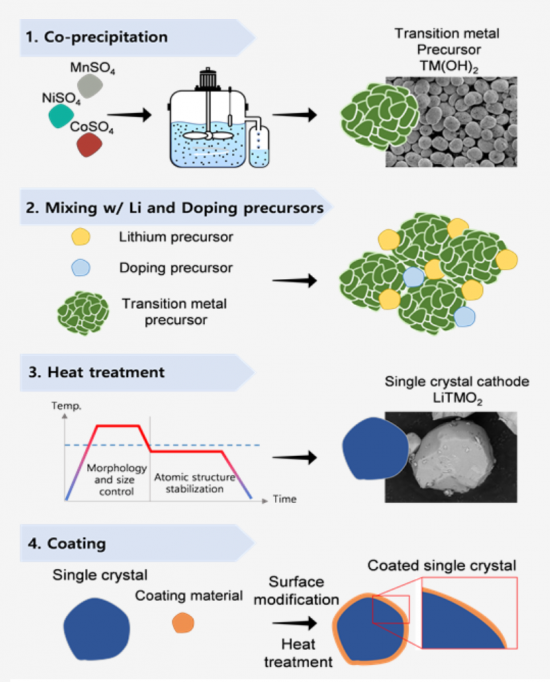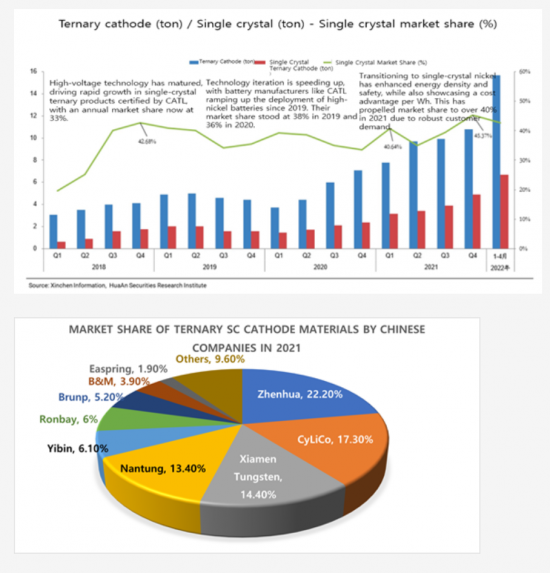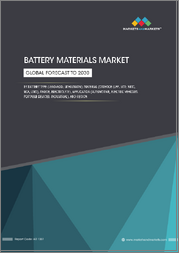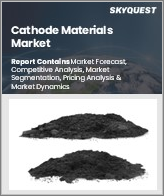
|
시장보고서
상품코드
1374456
<2023> 단결정(단입자) 양극재 기술개발 동향 및 시장 전망<2023> Single Crystal (Single Particle) Cathode Technology Development Trend and Market Outlook |
||||||
전기차 배터리 성능을 획기적으로 높일 수 있는 단결정 구조의 양극재 양산을 앞두고, 중국 및 한국의 업체간 경쟁이 본격화될 전망입니다.
현재 상용화된 전기차에 적용된 배터리 양극재는 수많은 금속화합물 결정이 모인 다결정 구조입니다. 그런데 이러한 양극 물질을 일정 두께로 만드는 압연 공정 및 충방전 과정에서 입자간 균열이 발생하기가 쉽습니다. 충전과 방전이 반복될수록 소재 사이의 균열이 생겨 틈이 커집니다. 균열에 의한 소재의 파괴는 배터리 내 가스발생을 증가시키고, 충방전 사이클을 감소시켜 수명감소로 이어집니다.
반면 단결정은 입자가 부서지지 않아 이런 문제가 없습니다. 또한 용량을 증가시키기 위해 소재내 니켈의 함량을 증가시킴에 따라 구조적인 안정성이 낮아지고 화재 위험성이 높아지고 있어 이에 대한 해결책으로 단결정 양극재의 개발 필요성이 커지고 있습니다.
단결정 양극재는 또한, 양극재 가공 비용을 낮추고 수율도 개선할 수 있습니다. 즉, 단결정 양극재는 잔해물이 없어 불량품 발생 확률을 낮추고 수세(washing)공정을 거칠 필요가 없기 때문입니다. 수세공정은 양극재를 만들 때 반드시 필요한 공정으로 물로 불순물을 제거하는 과정입니다.
단결정 양극재가 상용화되면 하이니켈 양극재 적용도 확대될 전망입니다. 또 가스발생이 줄면 그만큼 수명이 증가하고 더 많은 활물질로 내부를 채울 수 있어 에너지밀도를 높일 수 있습니다. 이를 전기차 배터리 팩에 적용하면 지금보다 더 적은 배터리 셀 개수로 1회 충전으로 500km이상의 주행거리를 달성하고, 롱레인지 모델 등 더 긴 주행거리를 갖춘 차량 라인업을 갖출 수 있게 됩니다. 즉 원가 절감과 성능 향상을 동시에 잡을 수 있는 게임 체인저가 될 수 있는 이유입니다.
그렇다고 단결정 양극재의 장점만 있는 것이 아니고 단점도 있습니다. 그간에 다결정 양극재 개발에 주력한 이유는 입자가 큰 단결정 소재는 초기 저항값이 높아 원하는대로 전압을 것 수 없었습니다. 이렇게 되면 제대로 된 출력이 나오지 않아 배터리 성능을 높일 수 없는 단점이 있기 때문이었습니다.
다만 추가 공정이 필요하고 작동 전압이 커서 배터리 온도가 상승할 수 있습니다. 또한 전극공정의 일부인 압연공정에서 단결정 입자가 손상될 수 있어서 양산 초기에는 순수한 단결정이 아니라 다결정과 섞어서 생산이 이루어질 것으로 보입니다.
이미 중국의 업체들은 NCM523, 622등에서 단결정 양극재를 생산하고 있으며, LG화학, 에코프로비엠, 엘앤에프, 포스코 퓨처엠 등 국내업체들도 대부분 개발을 마치고 고객사에 품질 테스트를 진행하고 있습니다. 단결정 NCA, NCM이 대상이며, 양산준비를 마친 상태로 볼 수 있습니다.
업계는 단결정을 만드는 것도 중요하지만, 내구성 확보를 위한 코팅 기술에서 성능과 품질이 판가름 될 것으로 전망합니다. 즉 입자크기를 키우면서 표면처리를 어떻게 할 것인지가 핵심입니다.
현재, 단결정 양극재의 양산에 의한 시장은 중국의 5대 선두업체가 전체 시장의 75%정도를 차지하고 있는 상황입니다.
한국의 각 양극업체의 발표에 의하면 23년 올해부터 샘플제공을 시작으로 25년에는 대략 12만톤 이상을 생산할 것으로 SNE Research는 전망하고 있습니다. 현재 중국의 삼원계 단결정 양극재의 경우, 60%-70%가 NCM 523등 5 시리즈 단결정 비중이 가장 높으며, NCM622 등 6 시리즈 단결정 비중은 18- 25% 정도를 차지하고 있으며, Ni함량이 80%이상인 8 시리즈인 경우는 21년부터 생산비중이 증가하여 현재는 약 15%를 점유하고 있는 것으로 나타나 있으며, 이 비중은 계속 증가할 것으로 보입니다.
SNE Research의 전망에 따르면, 한국의 경우, Ni함량에 따른 생산량 data가 아직 없어서 현재로선 시장 전망이 어려우나, 중국의 경우, 2025년 Hi-Ni이 약 42억달러, Mid-Ni이 92억달러로 전망되며, 2030년에는 Hi-Ni은 약 240억달러, Mid-Ni은 238억달러로 Hi-Ni의 시장이 더 커질 것으로 전망됩니다.
본 보고서의 Strong Point
- ① 단결정 Ni계 양극재개발의 fundamental 및 advances까지 내용 수록
- ② 단결정 Ni-rich계 양극재에 대한 아주 상세한 연구동향 및 향후 전망 수록
- ③ 단결정 Ni-rich계 양극의 용량열화 메커니즘 연구에 대한 내용 수록
- ④ 단결정 NCM 양극재의 주요 합성법에 대한 비교
- ⑤ 단결정 양극재 업체의 상세한 최근 동향 및 특허 분석
- ⑥ 단결정 양극재 시장 전망
1. 양극재 개요
- 1.1. 양극재 개발의 역사
- 1.2. 양극재를 둘러싼 최근의 동향
- 1.2.1. 층상 산화물 양극재
- 1.2.2. 스피넬 산화물 양극재
- 1.2.3. 폴리음이온 산화물 양극재
- 1.3. 양극재별 개발 현황
- 1.3.1. 미세구조 변경
- 1.3.2. 양극 균열 제거
- 1.3.3. One Pot Process 적용
- 1.3.4. 전자레인지 처리
2. 단결정 Ni-rich계 layered 양극재의 연구동향 및 향후 전망
- 2.1. 단결정 Ni-rich layered 소재 연구 필요성
- 2.1.1. Ni-rich layered소재의 필요한 이유 (장점)
- 2.1.2. Ni계 layered 양극소재 열화 메커니즘
- 2.1.3. Ni계 layered 양극소재 단결정화 (단입자화) 필요성
- 2.2. 단결정 양극재 정의
- 2.3. 단결정 양극재 기술 개발 현황
- 2.3.1 단입자 Ni계 layered 소재 합성 연구
- 2.3.2 단입자 Ni계 layered 소재 합성위한 소결 방법 연구
- 2.3.3. 단입자 Ni계 layered 소재 성능 개선위한 소재 개질 연구
- 2.3.3.1 표면 코팅 연구
- 2.3.3.2. 원소 치환 연구 (도핑)
- 2.3.3.2.1. 단일 도핑
- 2.3.3.2.2. 듀얼 도핑
- 2.3.3.3. 전해액 최적화 연구
- 2.3.4. 단입자 Ni계 layered 소재 활용 방안
- 2.3.4.1. Ni계 layered 소재 단입자화 전극 설계 관점에서 장점
- 2.3.4.2. Ni계 layered 소재 단입자화 전극 설계 관점에서 단점
- 2.3.4.3. Ni계 layered 소재 단입자화 문제점 해결 위한 연구
- 2.4. 소재 단입자를 통한 개선점
- 2.4.1. 입자 깨어짐 특성 완화
- 2.4.4.1. 전극 제작 공정에서의 프레스 단계
- 2.4.2. 충방전 과정에서의 입자 깨어짐
- 2.4.3. 비표면적 감소를 통한 표면 열화의 양적인 감소
- 2.4.4. 에너지 밀도 증가
- 2.4.5. 수세공정 생략 가능
- 2.4.1. 입자 깨어짐 특성 완화
- 2.5. 현 단결정 양극재 기술 개발 한계 및 해결 위한 연구
- 2.5.1. 합성 조건 최적화의 어려움으로 인한 소재 결정 구조의 열화
- 2.5.2. 입자 사이즈 한계
3. 단결정 Ni계 양극재 개발: Fundamental 및 advances
- 3.1. 개요
- 3.2. Ni계 양극재
- 3.2.1. 화학구조
- 3.2.2. 전자구조
- 3.3. Ni계 층상 산화물의 과제
- 3.3.1. 합성의 어려움
- 3.3.2. 구조적 불안정성
- 3.3.3. 화학적 불안정성
- 3.3.4. 기계적 성능 저하
- 3.3.5. 안전성 문제
- 3.4. 단결정 Ni계 층상 산화물의 유래
- 3.5. 단결정 Ni계 층상 산화물의 합성
- 3.5.1. 합성 방법
- 3.6. 단결정과 다결정 재료의 비교 연구
- 3.7. 단결정 Ni기반 양극재의 최신 공정
- 3.7.1. 도핑과 표면 코팅
- 3.7.2. 기계적 연구
- 3.8. 결과 및 결론
4. 단결정 Ni-rich NCM 양극의 용량열화 메커니즘 연구
- 4.1. 개요
- 4.2. Ni-rich 단결정, 다결정 양극의 기본특성 평가
- 4.2.1. 단결정, 다결정 양극재 합성
- 4.2.2. 단결정, 다결정 양극재 조성 및 분석
- 4.2.3. 단결정, 다결정 양극재의 전기화학적 특성
- 4.2.4. 단결정, 다결정 양극재의 구조적 응력분석
- 4.2.5. 단결정, 다결정 양극재의 in-situ XRD 분석
- 4.2.6. 단결정, 다결정 양극재의 TEM 분석
- 4.2.7. 결과 및 결론
5. 단결정 Ni-rich 양극재의 입자제어 (소결 조제 적용)
- 5.1. 개요
- 5.2. 실험에 대한 설명
- 5.3. 실험 결과
- 5.3.1. 결정성장 촉진을 위한 소결 조제의 최적화
- 5.3.2. 결정성장 메카니즘
- 5.3.3. Ni-rich 단결정 양극의 구조
- 5.3.4. Ni-rich 단결정 양극의 성능
- 5.4. 소결 조제의 적용 결과
6. 단결정 NCM 양극재의 올 건식 합성법(All Dry Synthesis)
- 6.1. 개요
- 6.2. 건식 합성
- 6.3. 건식 합성 결과 및 논의
- 6.3.1. 전구체 구조 및 형태
- 6.3.2. NCM 형성에 대한 소결 조건의 영향
- 6.3.3. 볼 밀링 전구체의 단결정 NCM
- 6.3.4. 결론
7. 단결정 NCM523 양극재의 One Spot Synthesis
- 7.1. 개요
- 7.2. NCM523의 합성
- 7.3. 재료의 특성화(Characterization)
- 7.4. 전기화학적 특성
- 7.5. 실험결과 및 논의
- 7.5.1. 양극재 합성 결과물 분석
- 7.5.2. 양극재의 전기화학적 특성
- 7.5.3. 결론
8. 단결정 NCM 양극재의 합성 및 개질(modification)
- 8.1. 개요
- 8.2. 성장 메커니즘(NCM양극에 대한 고려사항)
- 8.3. Solid state 반응
- 8.4. 고체-액체 유변학적 반응
- 8.5. 용융염 Flux에서의 결정 성장
- 8.6. Modification of morphology
- 8.6.1. 모양 제어
- 8.6.2. Facet의 조절
- 8.6.3. 결론
9. 단결정 양극재 개발: DOE Program
- 9.1. Ni-rich 단결정 양극재의 초고속 수열법에 의한 생산
- 9.2. Ni-rich 고성능 단결정 양극재의 scale-up (advanced Salt적용)
- 9.3. 고성능 전고체 LIB를 구현하는 단결정 양극재
10. 단결정 양극재 업체 특허 분석
- 10.1. Tesla
- 10.2. LG Chem
- 10.3. SM Lab
- 10.4. Nano One Materials
- 10.5. 포스코 퓨처엠
- 10.6. 코스모 신소재
- 10.7. 엘엔에프
- 10.8. Easpring
- 10.9. BASF Shan Shan
- 10.10. GEM
- 10.11. XTC (Xiamen Tungsten)
- 10.12. Henan Kelong
- 10.13. 현대/기아자동차
- 10.14. 6K Inc.
- 10.15. Dynanonic
- 10.16. Suzhou Long Power
- 10.17. Fengchao Energy
- 10.18. Ecopro BM
- 10.19. Umicore
11. 단결정 양극재 업체 동향
- 11.1. LG Chem
- 11.2. 포스코 퓨처엠
- 11.3. 에코프로비엠
- 11.4. Zhenhua E-Chem(ZEC)
- 11.5. Chanyuan Lico
- 11.6. Ronbay
- 11.7. XTC (Xiamen Tungsten)
- 11.8. Tianjin B&M
- 11.9. Easpring
- 11.10. Reshane
- 11.11. Yibin Libode
- 11.12. Wanxing 123
- 11.13. GEM
12. 단결정 양극재 시장 전망
- 12-1. 2017-2022H1 중국 단결정 생산량
- 12-2. 2019-2022.04 중국 단결정 생산량과 양극재에서의 비중
- 12-3. 2019-2022Q1 중국의 삼원계 단결정 양극재별 생산량 분포
- 12-4. 2019-2022Q1 중국의 삼원계 단결정 양극재별 생산량 비중
- 12-5. 2019-2022Q1 중국의 삼원계 단결정 양극재별 시장 침투율
- 12-6. 2021년 중국 업체별 삼원계 양극재 시장 점유율
- 12-7. 2021년 중국 삼원계 단결정 양극재 업체별 생산량 및 점유율
- 12-8. 한국-중국 삼원계 단결정 생산량 전망
- 12-9. 한국 삼원계 단결정 양극재 시장 전망
- 12-10. 중국 삼원계 양극재 중 단결정 양극재의 사용 비율
- 12-11. 중국 삼원계 단결정 양극재별 생산량 비중 전망
- 12-12. 중국 삼원계 단결정 양극재별 생산량 시장 전망
References
The mass production of single-crystal cathodes, poised to significantly enhance electric vehicle battery performance, is imminent, heralding an anticipated escalation in competition between Chinese and Korean companies.
In commercial electric vehicle batteries, the cathode materials currently employed consist of polycrystalline structures comprising multiple metal compound crystals. However, cracks often develop between these particles during the rolling process to achieve uniform thickness, as well as during charging and discharging. With repeated cycles, these cracks expand, resulting in material deterioration, increased gas generation within the battery, and a decline in charging/discharging cycles, ultimately diminishing battery longevity.
Single crystals, unlike their polycrystalline counterparts, are immune to this issue as their particles remain intact. Moreover, as nickel content rises to boost capacity, structural stability decreases, heightening the risk of fire. Hence, the development of single crystal cathodes emerges as a solution to this challenge.
Single crystal cathodes offer cost savings and enhanced yields by eliminating residual materials, thereby lowering defect probability and obviating the need for a washing process. This step, crucial in cathode manufacturing for impurity removal, becomes unnecessary with single crystal technology.
The commercialization of single-crystal cathodes is poised to broaden the utilization of high-nickel cathodes. With reduced gas generation, battery lifespan extends while accommodating more active material, boosting energy density. Implementing this in electric vehicle battery packs could enable over 500 km of driving range on a single charge with fewer cells, facilitating longer-range vehicle models. This potential game-changer promises both cost reduction and performance enhancement simultaneously.
Yet, single crystal cathodes also pose drawbacks. Unlike polycrystalline counterparts, large single crystal materials exhibit high initial resistance, challenging the application of desired voltage. Consequently, output remains low, impeding battery performance enhancement.
However, single crystal cathodes entail extra processing steps and operate at higher voltages, potentially raising battery temperatures. Moreover, single crystal particles are susceptible to damage during the calendering process, a crucial part of electrode manufacturing.
Consequently, in the initial stages of mass production, single crystals are likely to be blended with polycrystals rather than being produced in their pure form.
Chinese companies are already producing single crystal cathodes for NCM523 and 622, and domestic companies such as LG Chem, Ecopro BEM, L&F, and POSCO FutureM have also completed development and are conducting quality tests with clients. The targets are single crystal NCA and NCM, and it can be seen that they are ready for mass production.
Industry experts anticipate that the performance and quality of single crystal cathodes will hinge on coating technology to ensure durability and the manufacturing process of single crystals. Essentially, the focus lies in effectively conducting surface treatment while simultaneously augmenting particle size.
Currently, the market for mass-produced single crystal cathodes is dominated by the top 5 Chinese companies, which account for about 75% of the total market.
According to announcements by Korean cathode material companies, SNE Research predicts that they will start supplying samples this year (2023) and produce more than 120,000 tons in 2025. Currently, in the case of Chinese ternary single crystal cathodes, the proportion of 5 series single crystals, such as NCM 523, is the highest at 60% to 70%. The proportion of 6 series single crystals, such as NCM622, is 18 to 25%. In the case of 8 series with a Ni content of 80% or higher, the production ratio has increased since 2021 and currently accounts for about 15%. This proportion is expected to continue to increase.
According to SNE Research, it is difficult to predict the market for Korea at this time because there is no data on production volume by Ni content. However, in the case of China, Hi-Ni is expected to be about $4.2 billion and Mid-Ni is expected to be $9.2 billion in 2025. In 2030, Hi-Ni is expected to be about $24 billion and Mid-Ni is expected to be $23.8 billion, so the market for Hi-Ni is expected to be larger.
Strong Points of this report:
- 1. Cover fundamental and advances in the development of single-crystal Ni-rich cathode materials
- 2. Include a very detailed study of research trends and future prospects for single-crystal Ni-rich cathode materials.
- 3. Include content on research regarding the capacity degradation mechanism of single-crystal Ni-rich cathodes.
- 4. Compare major synthesis methods for single-crystal NCM cathode materials
- 5. Detailed recent developments and patent analysis of single-crystal cathode material manufacturers
- 6. Market outlook for single-crystal cathode materials
[Schematic diagram of general single-crystal Ni-rich layered cathode material synthesis and additional modification process]


Table of Contents
1. Overview of Cathode Materials
- 1.1. History of Cathode Material Development
- 1.2. Recent Trends in Cathode Materials
- 1.2.1. Layered Oxide Cathode Materials
- 1.2.2. Spinel Oxide Cathode Material
- 1.2.3. Polyanionic Oxide (PAO) Cathode Materials
- 1.3. Development Status of Cathode Materials by Type
- 1.3.1. Microstructure Modification
- 1.3.2. Removal of Cathode Cracks
- 1.3.3. Application of the One-Pot process
- 1.3.4. Microwave Processing
2. Research Trends and Future Prospects of Single Crystal Ni-rich Layered Cathodes
- 2.1. Need for Research on Single Crystal Ni-rich Layered Materials
- 2.1.1. The Need for Ni-rich Layered Materials (Advantages)
- 2.1.2. Degradation Mechanisms of Ni-rich Layered Cathode Materials
- 2.1.3. Need for Single Crystallization (Monoparticulation) of Ni-rich Layered Cathode Materials
- 2.2. Definition of Single-crystal Cathode Material
- 2.3. Development Status of Single-crystal Cathode Material Technology
- 2.3.1. Single-particle Ni-rich Layered Material Synthesis Research
- 2.3.2. Research on Sintering Methods for Synthesis of Single-particle Ni-rich Layered Materials
- 2.3.3. Study on Modifying Materials to Enhance Performance of Single-particle Ni-rich Layered Materials
- 2.3.3.1. Surface Coating Research
- 2.3.3.2. Elemental Substitution Study (Doping)
- 2.3.3.2.1. Single Doping
- 2.3.3.2.2. Dual Doping
- 2.3.3.3. Electrolyte Optimization
- 2.3.4. Utilization Strategies for Single-Crystal Ni-Based Layered Materials
- 2.3.4.1. Advantages of Single-Crystallization in Ni-Based Layered Cathodes for Electrode Design
- 2.3.4.2. Disadvantages of Single-Crystallization in Ni-Based Layered Cathodes for Electrode Design
- 2.3.4.3. Research on Addressing Challenges in Single-Crystallization of Ni-Based Layered Materials
- 2.4. Improvement Through Material Single-Particle Formation
- 2.4.1. Mitigation of Particle Breakage Characteristics
- 2.4.4.1. Pressing Stage in Electrode Manufacturing
- 2.4.2. Particle Breakage During Charge-Discharge Processes
- 2.4.3. Quantitative Reduction of Surface Degradation through Reduced Specific Surface Area
- 2.4.4. Energy Density Increase
- 2.4.5. Washing Process Omission
- 2.4.1. Mitigation of Particle Breakage Characteristics
- 2.5. Limitations of Current SC Cathode Material Technology Development and Research for Overcoming Them
- 2.5.1. Degradation of Material Crystal Structure Due to Difficulties in Optimizing Synthesis Conditions
- 2.5.2. Particle Size Limit
3. Single-Crystal Ni-Based Cathode Materials: Fundamentals and Advances
- 3.1. Overview
- 3.2. Ni-based Cathode Materials
- 3.2.1. Chemical Structure
- 3.2.2. Electronic Structure
- 3.3. Challenges of Ni-based Layered Oxides
- 3.3.1. Synthesis Difficulties
- 3.3.2. Structural Instability
- 3.3.3. Chemical Instability
- 3.3.4. Mechanical Performance Degradation
- 3.3.5. Safety Issues
- 3.4. Origin of Single-Crystal Ni-Based Layered Oxides
- 3.5. Synthesis of Single-Crystal Ni-based Layered Oxides
- 3.5.1. Synthesis Methods
- 3.6. Comparative Study of Single-Crystal and Polycrystalline Materials
- 3.7. Recent Advances in Single-Crystal Ni-Based Cathode Materials
- 3.7.1. Doping and Surface Coating
- 3.7.2. Mechanical Research
- 3.8. Results and Conclusion
4. Study of Capacity Fading Mechanism of Single-crystal Ni-rich NCM Cathode
- 4.1. Overview
- 4.2. Assessment of Fundamental Properties in Ni-rich Single-crystal and Polycrystalline Cathodes
- 4.2.1. Single-crystal and Polycrystalline Cathode Synthesis
- 4.2.2. Composition and Analysis of Single-crystal and Polycrystalline Cathodes
- 4.2.3. Electrochemical Properties of Single-crystal and Polycrystalline Cathodes
- 4.2.4. Structural Stress Analysis of Single-crystal and Polycrystalline Cathode Materials
- 4.2.5. In-situ XRD Analysis of Single-crystal and Polycrystalline Cathodes
- 4.2.6. TEM Analysis of Single-crystal and Polycrystalline Cathode Materials
- 4.2.7. Results and Conclusions
5. Particle Control of Ni-rich Monocrystalline Cathode Materials (Application of Sintering Process)
- 5.1. Overview
- 5.2. Experiment Description
- 5.3. Experimental Results
- 5.3.1. Optimization of Sintering Additives for Promoting Crystal Growth
- 5.3.2. Crystal Growth Mechanism
- 5.3.3. Ni-rich Structure of a Single Crystal Cathode
- 5.3.4. Performance of Ni-rich Single Crystal Cathodes
- 5.4. Application Results of Sintering Treatment
6. All-Dry Synthesis of Single-Crystal NMC Cathode Materials
- 6.1. Overview
- 6.2. Dry Synthesis
- 6.3. Dry Synthesis Results and Discussion
- 6.3.1. Precursor Structure and Morphology
- 6.3.2. Effect of Sintering Conditions on NMC Formation
- 6.3.3. Single-crystal NCM from Ball-milled Precursors
- 6.3.4. Conclusion
7. One-Spot Synthesis of Single Crystal NCM523 Cathode Material
- 7.1. Overview
- 7.2. Synthesis of NCM523
- 7.3. Characterization of Materials
- 7.4. Electrochemical Properties
- 7.5. Experiment Results and Discussion
- 7.5.1. Cathode Material Synthesis Product Analysis
- 7.5.2. Electrochemical Properties of Cathode Materials
- 7.5.3. Conclusion
8. Synthesis and Modification of Single-Crystal NCM Cathode Materials:Growth Mechanism
- 8.1. Overview
- 8.2. Growth Mechanism for NCM Cathodes
- 8.3. Solid State Reaction
- 8.4. Solid-Liquid Rheological Reaction
- 8.5. Crystal Growth in Molten Salt Flux
- 8.6. Modification of morphology
- 8.6.1. Control of Shape
- 8.6.2. Facet Control
- 8.6.3. Conclusion
9. Development of Single-Crystal Cathodes: DOE Program
- 9.1. Ultrafast Hydrothermal Synthesis of Ni-rich Single-Crystal Cathodes
- 9.2. Scaling up of High Performance Single Crystalline Ni-rich Cathode Materials with Advanced Lithium
- 9.3. Single-Crystal Cathodes for High-Performance All-Solid-State LIBs
10. Patent Analysis of Single Crystal Cathode Material Companies
- 10.1. Tesla
- 10.2. LG Chem
- 10.3. SM Lab
- 10.4. Nano One Materials
- 10.5. POSCO Future M
- 10.6. COSMO Advanced Materials & Technology
- 10.7. L&F
- 10.8. Easpring
- 10.9. BASF Shan Shan
- 10.10. GEM
- 10.11. XTC (Xiamen Tungsten)
- 10.12. Henan Kelong
- 10.13. Hyundai Motor Company / Kia Corporation
- 10.14. 6K Inc.
- 10.15. Dynanonic
- 10.16. Suzhou Long Power
- 10.17. Fengchao Energy
- 10.18. Ecopro BM
- 10.19. Umicore
11. Single-Crystal Cathode Material Industry Trends
- 11.1. LG Chem
- 11.2. POSCO FutureM
- 11.3. EcoPro BM
- 11.4. Zhenhua E-Chem(ZEC)
- 11.5. Chanyuan Lico
- 11.6. Ronbay
- 11.7. XTC (Xiamen Tungsten)
- 11.8. Tianjin B&M
- 11.9. Easpring
- 11.10. Reshane
- 11.11. Yibin Libode
- 11.12. Wanxing 123
- 11.13. GEM
12. Single Crystal Cathode Market Outlook
- 12-1. 2017~2022H1 China Single Crystal Production Volume
- 12-2. 2019~2022.04 Production Volume and Share of Single Crystal Cathode Materials in China
- 12-3. 2019~2022Q1 Distribution of production volume by SC ternary cathode materials in China
- 12-4. 2019~2022Q1 Share of production by ternary SC cathode material in China
- 12-5. 2019~2022Q1 Market Penetration by Ternary SC Cathode Materials in China
- 12-6. Market Share of Ternary SC Cathode Materials by Chinese Companies in 2021
- 12-7. Production Volume and Market Share of Ternary SC cathode Material Companies in China in 2021
- 12-8. Korea-China Ternary Single Crystal Production Forecast
- 12-9. Korean Ternary SC Cathode Material Mroduction Volume and Market Outlook
- 12-10. Percentage of Single-crystal Cathodes among Ternary Cathode Materials in China
- 12-11. Forecast of Production Volume Ratio by Chinese Ternary Single Crystal Cathode Material
- 12-12. China Market Forecast by Ternary Single Crystal Cathode Material
References
(주말 및 공휴일 제외)


















